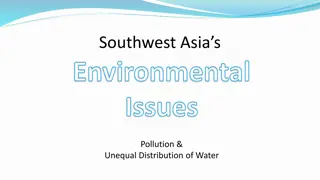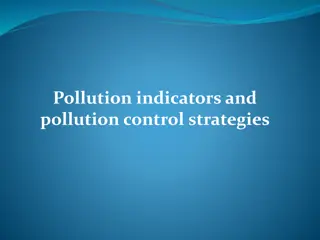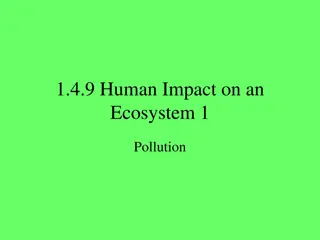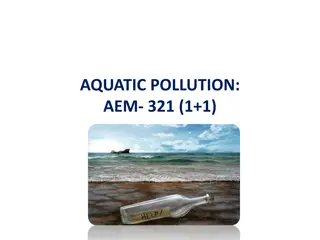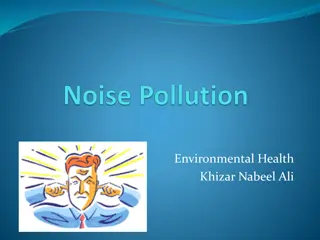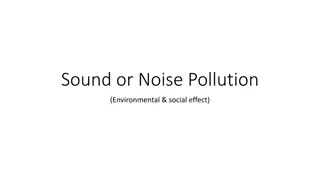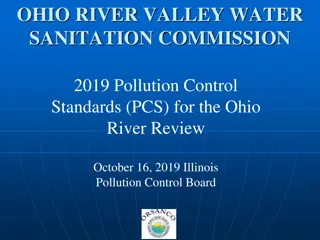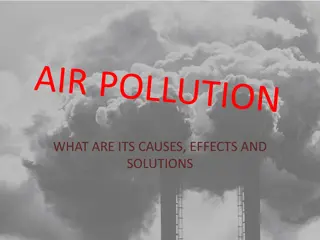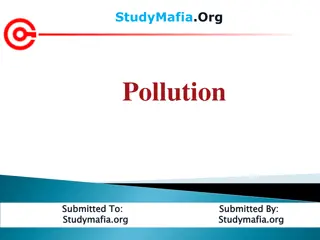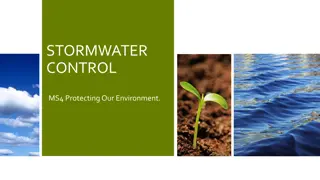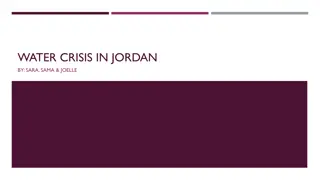Understanding Water Pollution and Its Impact on the Environment
Water pollution is a significant environmental issue caused by the contamination of water bodies with toxic substances like chemicals and microorganisms. This degradation in water quality poses risks to both humans and ecosystems. The pollutants stem from various sources such as agricultural runoff, industrial discharges, and hazardous waste sites. Understanding the types of pollutants and their effects is crucial in addressing and mitigating water pollution across different bodies of water like surface water, groundwater, and marine environments.
Download Presentation

Please find below an Image/Link to download the presentation.
The content on the website is provided AS IS for your information and personal use only. It may not be sold, licensed, or shared on other websites without obtaining consent from the author. Download presentation by click this link. If you encounter any issues during the download, it is possible that the publisher has removed the file from their server.
E N D
Presentation Transcript
DEPARTMENT OF ZOOLOGY DEPARTMENT OF ZOOLOGY PATNA UNIVERSITY,PATNA PATNA UNIVERSITY,PATNA Dr. Anupma Kumari Associate Professor M.Sc. Semester II Core Course (CC-5):Environmental Science Topic: Water Pollution
WATER POLLUTION WATER POLLUTION
INTRODUCTION: Water pollution occurs when toxic substances(often chemicals or microorganisms) contaminate a stream, river, lake, ocean, aquifer or other body of water, degrading water quality and rendering it toxic to humans or the environment. These toxic substances (pollutants) include fertilizers and pesticides from agricultural runoff; sewage and food processing waste; lead, mercury and other heavy metals; chemical wastes from industrial discharges and chemical contamination from hazardous waste sites. Categories of water pollution: Surface water pollution- Surface water pollution is the pollution of aquatic systems that are above ground, such as streams, lakes and rivers.
Ground water pollution: Groundwater pollution occurs as a result of release of pollutants into the ground to natural underground water reservoir known as aquifers. Marine pollution: Any detrimental alteration of the marine environment caused by the intentional or accidental release of dangerous or toxic substances, such as industrial, commercial and urban waste water is known as marine pollution. Sources of water pollution Point sources are distinct and confined, such as pipes from industrial or municipal sites that empty into streams or rivers Nonpoint sources, such as runoff, are diffused and intermittent and are influenced by factors such as land use, climate, hydrology, geology etc.
Non Non- -point source point source
Point Source Point Source
TYPES OF POLLUTANTS 1. ORGANIC POLLUTANTS: Organic pollutants are very wide in variety with a huge range of toxicity. It consists of protein, carbohydrates, fats and nucleic acids in a multiplicity of combinations. Among the list of organic pollutants that has been of great threat to aquatic organisms, human, plant and animal are dyes, pharmaceuticals, personal care product wastes as well as petroleum organic pollutants. Sources: Domestic sewage(raw, untreated), urban runoff, industrial effluents Effects: When an organic pollutants is discharged into a river, it is generally eliminated by the activities of micro-organism. Micro-organism required sufficient concentration of oxygen to decompose organic pollutants resulting in decrease of Dissolved Oxygen concentration and increase in BOD load.
At high BOD levels, organisms such as macro invertebrates that are more tolerant of lower dissolved oxygen (DO), i.e., leeches and sludge worms may appear and become numerous. Organisms which survive on higher DO levels, i.e., Caddisfly Larvae and Mayfly Nymphs will not survive. CADDISFLY LARVAE MAYFLY NYMPHS
Pathogens: A pathogen is usually defined as a micro-organism that causes, or can cause, disease. Fecal contamination of water can introduce a variety of pathogens into waterways, including bacteria, viruses, protozoa and helminths. The most frequently used indicators in the fecal pollution are the coliform bacterium(e.g. E.coli), Clostridium. Fecal streptococci and Sources: Sewage effluent, Domestic effluent, Industrial effluent
B BACTERIA ACTERIA PATHOGEN CLASS EXAMPLES DISEASES Bacteria Shigella sp. Bacillary dysentery Salmonella typhi Typhoid fever Salmonella paratyphi Paratyphoid fever Vibrio cholera Cholera E. coli Gastroenteric diseases Mycobacterium Tuberculosis Campylobacter jejuni Campylobacteriosis
VIRUSES VIRUSES PATHOGEN CLASS EXAMPLES DISEASES Viruses Hepatitis A virus Infectious hepatitis Norovirus Acute gastroenteritis Rotavirus Acute gastroenteritis Poliovirus Poliomyelitis Coxsackievirus Flu-like symptoms Echovirus Flu-like symptoms
PROTOZOANS PROTOZOANS PATHOGEN CLASS EXAMPLES DISEASES Protozoans Entamoeba histolytica Amoebiasis (Amoebic dysentery) Giardia lamblia Giardiasis (gastroenteritis) Cryptosporidium sp. Cryptosporidiosis (gastroenteritis) Balantidium coli Balantidiasis (gastroenteritis)
HELMINTHS HELMINTHS PATHOGEN CLASS EXAMPLES DISEASES Helminths Ascaris sp. Ascariasis (roundworm infection) Taenia sp. Taeniasis (tapeworm infection) Necator americanus Ancylostomiasis (hookworm infection) Trichuris trichuria Trichuriasis (whipworm infection)
2.PESTICIDES AS WATER POLLUTANTS: The term pesticide is a composite term that includes all chemicals that are used to kill or control pests. In agriculture, this includes herbicides, insecticides, fungicides, nematicides and rodenticides. e.g. Aldrin, Dieldrin, DDT, Endrin, Mirex, Toxaphene, Endosulfan,2-4D etc Factors affecting pesticide toxicity in aquatic systems: Toxicity: Mammalian and non-mammalian toxicity usually expressed as LD50. The lower the LD50 , the greater the toxicity; values of 0-10 are extremely toxic (OMAF,1991). Toxic response can be acute( death) or chronic( an effect that does not cause death over the test period but which causes observable effects in the test organisms such as cancers and tumors, reproductive failure, teratogenic effects etc.)
Persistence: Measured as half-life( time required for the ambient concentration to decrease by 50%). It is determined by biotic and abiotic degradation process. Degradate: The degradation process may lead to formation of degradate which may have greater, equal or lesser toxicity than the parent compound. e.g. DDT degrades to DDD and DDE. Environmental fate: The environmental fate (behavior) of a pesticide is affected by the natural affinity of the chemical for one of four environmental compartments: solid matter (mineral matter and particulate carbon), liquid (solubility in surface and soil water), gaseous form (volatilization ) and biota.
SOURCES AND SETTINGS OF EXPOSURE Indoor and outdoor application Mosquito control Professional/ domestic application Health uses Lice or scabies Fleas or ticks on pets Pesticide residues Dust, soil, furniture, carpets, toys, food Playgrounds, playing fields, lawns, gardens Wood preservatives in play structures (e.g. PCP: pentachlorophenol) Long range transport of POPs( DDT)
ROUTES FOR ENTRY OF PESTICIDES INTO WATER Non-point sources : Spray Drift Surface runoff Leaching Drain flow Point sources : Sewage effluent Industrial effluent
Pesticide drift Pesticide drift
ECOLOGICAL EFFECTS The principal pathway that causes ecological impacts is that of water contaminated by pesticide runoff. The two principal mechanisms are- Bioconcentration : Movement of chemical from the surrounding medium into organism. The primary sink for some pesticides is fatty tissue. e.g. DDT accumulate in fatty tissue of fish whereas Glyphosate are metabolized and excreted. Biomagnification : The process by which a compound (Such as a pollutant or pesticide) increases its concentration in the tissues of organisms as it travels up the food chain. e.g. DDT is a persistent contaminant that biomagnifies up the food chain, causing mortality, reproductive failure and other health effects in predatory wildlife and humans.
EFFECTS AT THE ORGANISM OR ECOLOGICAL LEVEL EFFECTS AT THE ORGANISM OR ECOLOGICAL LEVEL The major types of effect are listed below and will vary depending on the organism and the type of pesticide. Death of the organism Cancers, tumors and lesions on fish and animals Reproductive inhibition or failure Suppression of immune system Disruption of endocrine system Cellular and DNA damage Teratogenic effects Intergenerational effects Other physiological effects such as egg shell thinning.
3.FERTILIZERS AS POLLUTANTS: Fertilizers: Any organic or inorganic material of natural or synthetic origin that is added to soil to supply one or more plant nutrients (nitrogen, phosphorus, small amount of potassium) essential to growth of plants. Sources: Agricultural runoff, Leaching 1.Effects on human health due to nitrate: Blue Baby Syndrome: The most common cause of blue baby syndrome is water contaminated with nitrates.When large amount of nitrates in water are ingested by an infant, the body converts the nitrates into nitrites. These nitrite then bind to the hemoglobin in the body, forming methemoglobin, which is unable to carry oxygen. If a large enough amount of methemoglobin is formed in the blood, blood tissue may be deprived of oxygen, causing the infant to develop a blue colouration of their mucous membranes and possibly digestive and respiratory problems. This condition is also known as methemoglobinemia.
2.Effects Due to Nutrients: Eutrophication ( from Greek eutrophos, well- nourished ): The process by which a body of water becomes enriched in dissolved nutrients (such as phosphorus and nitrogen) that stimulate the growth of aquatic plant life usually resulting in the depletion of dissolved oxygen.
Ammonia It is a colourless pungent gaseous compound of hydrogen and nitrogen that is highly soluble in water. It is a biologically active compound found in most waters as a normal biological degradation product of nitrogenous organic matter (protein). EFFECTS: Increase pH value of water, causing stomach disorder Blocks oxygen transfer in the gills of fish
4. HEAVY METALS AS POLLUTANTS: a. Mercury Pollution: SOURCES: It enters water naturally as well as through industrial effluents. EFFECTS: Both inorganic and organic forms are highly poisonous. Mercury poisoning is caused due to inactivation of several sulfhydral enzymes by replacement of hydrogen atoms in sulfhydral groups. Mercury was responsible for Minamata epidemic that caused several deaths in Japan and Sweden. The tragedy had occurred due to consumption of heavily mercury contaminated fish (27 to 102 ppm, average 50 ppm).
b. Lead Pollution: SOURCES: Effluents of lead and lead processing industries. EFFECTS: Lead pollution caused damage to liver, kidney, reduction in heamoglobin formation, mental retardation and abnormalities in fertility and pregnancy. Chronic lead poisoning may cause three general disease syndromes: 1. Gastro-intestinal disorders 2. Neuromuscular effects (leadlapsy) 3. CNS syndrome that may result to coma and death.
c. Fluoride Pollution: SOURCES: Fluorides may enter a river as a result of industrial discharges. In groundwater, fluoride concentrations vary with the type of rock the water flows through. EFFECTS: On an average about 20-25 million Indians are affected with fluorosis. In our country this problem has become more severe in Rajasthan. Many people in Rajasthan have humped back due to high fluoride content in water sources in arid and semi arid zones. Prolonged intake of fluoride containing water stiffens the bone joints, particularly of spinal cord. Fluoride is not absorbed in the blood stream. It has an affinity with calcium and thus get accumulated in bones, resulting in the mottling of teeth, pain in the bones and joint and outward bending of legs from the knees (Knock Knee syndrome).
d. Arsenic Pollution: SOURCES: Arsenic contamination of groundwater is a form of groundwater pollution which is often due to naturally occurring high concentrations of arsenic in deeper levels of groundwater. EFFECTS: In South Asia, arsenic contamination in groundwater in the Ganga- Brahmaputra fluvial plains in India and Padma-Meghna fluvial plains in Bangladesh has been found to have a huge impact on human health and its consequences have been reported as the world s biggest groundwater calamities. It causes Arsenicosis, which occurs due to accumulation of large amounts of arsenic in the body. Arsenicosis leads to adverse health effects through inhibition of essential enzymes which ultimately leads to death from multi system organ failure.
5.Thermal pollution The broadest definition of thermal pollution is the degradation of water quality by any process that changes ambient water temperature. Thermal pollution is usually associated with increases of water temperatures in a stream, lake or ocean due to the discharge of heated water from industrial processes, such as the generation of electricity. SOURCES: The major sources of thermal pollution are discharge of heated water into water bodies from:- Nuclear power plant Hydroelectric power Coal fired power plants Industrial effluents Thermal shock
Iceland Geothermal Power Plant Iceland Geothermal Power Plant
Effects: Elevated temperature decreases the level of dissolved oxygen of water. Increases the metabolic rate of aquatic animals. Warmer water can reduce the fertility of some organisms. Other species may suffer birth defects or lay deformed eggs because of chemical changes in the body caused by warmer water. High temperature limits oxygen dispersion into deeper waters, contributing to anaerobic conditions. Changes in the environment may also result in a migration of organisms to another, more suitable environment. Loss of biodiversity Increased toxins
6.OIL POLLUTANTS An oil spill is the release of a liquid petroleum hydrocarbon into the environment especially marine areas due to human activity and is the form of pollution SOURCES: Pipeline spills, tank vessel spills, operational discharges from cargo washings, coastal facilities spills, and gross atmospheric deposition of Volatile Organic Compounds(VOCs)s releases from tankers. EFFECTS: -Oil spills frequently kill marine mammals such as whales, dolphins, seals and sea otters. -Oil can clog blowholes of whales and dolphins ,making it impossible for them to breathe properly and disrupting their ability to communicate. -Oil coats fur of otters and seals, leaving them vulnerable to hypothermia. -Oil spills destroyed eggs of fishes such as salmon and herring eggs. - Long-term damage to species and their habitats and nesting or breeding ground is one of the most far-reaching environmental effects caused by oil spills. -Oil spills can disrupt migratory patterns of birds.
Exxon Valdez oil spill-The Exxon Valdez oil spill occurred in Prince William Sound, Alaska, March 24,1989, when Exxon Valdez, an oil tanker owned by Exxon Shipping Company, bound for Long Beach, California, struck Prince William Sound s Bligh Reef, Alaska
7. RADIOACTIVE POLLUTANT Radioactive pollution is the deposition of, or presence of radioactive substances on surfaces or within solids, liquids or gases, where their presence is undesirable. Sources: Radioactivity present in surface continental waters is mainly due to the presence of radioactive elements in the earth s crust. Other artificial radionuclides have appeared due to such human activities as nuclear power plants, nuclear weapons testing and manufacture and use of radioactive sources. There are two sources of radioactive contamination in drinking water. The first is naturally occurring radionuclides that are contained in the soil that water moves through. The second source of radioactive contamination come from man-made sources.
Effects: Radionuclides found in drinking water are uranium, thorium and actinium and include the naturally occurring elements radium, uranium and the radioactive gas radon. Radium concentrates in the bones and can cause cancers. Uranium can cause cancers in the bones and can have a toxic effect on kidneys. Bean et al.(1982) found increased rates of bladder cancer in males, breast cancer in females and lung cancer in both sexes in association with increasing 226 Ra concentration in community water supply. In aquatic system, radiation can cause mutation, chromosome breakage, faulty segregation of chromosome among aquatic species. e.g. mutation in germ cells of Rainbow trout and Brine shrimp, aberrations in salivary gland chromosome of Midges. Radiation can reduce fecundity, viability and fertility of freshwater snail and egg production was reduced in Amphipod. The effects of radiation on freshwater species results in loss of some species which leads to reduction in diversity of species.
In Human Beings: Low levels of localized exposure may only have a superficial effect and cause mild skin irritation. Radioactivity is a health risk because the energy emitted by radioactive materials can damage or kill cells. Long term exposure or exposure to high amounts of radiation can have serious health impacts. Radiation can cause irreparable damage to DNA molecules and can lead to a life threatening condition. The rapidly growing/dividing cells such as skin, bone marrow are more sensitive towards radioactive emissions. On the other hand, cells that do not undergo rapid cell division such as bone cells and nervous cells, aren t damaged so easily. Skin cancer, lung cancer and thyroid cancer are some of the common types of cancers caused by radiation effect.
Radiation can harm biological systems by Radiation can harm biological systems by damaging the DNA of cells damaging the DNA of cells
8.POLLUTION DUE TO SEDIMENS: Sediment is the loose sand, clay, silt and other soil particles that settle at the bottom of a body of water SOURCES: Soil erosion, decomposition of plants and animals. EFFECTS: Increased turbidity and decreased transparency High levels of turbidity limit penetration of sunlight into the water column, thereby limiting growth of algae and rooted aquatic plants. Disrupt the natural food chain by destroying the habitat Finer suspended solids such as silt and coal dust may injure the gills of fishes and cause asphyxiation. High levels of sedimentation in rivers leads to physical disruption of the hydraulic characteristics of the channel. This can have serious impacts on navigation through reduction in depth of channel and can lead to increased flooding.
Biological treatment Biological treatments rely on bacteria, nematodes or other small organisms to break down organic wastes using normal cellular processes. The goal of biological wastewater treatment is to create a system in which the results of decomposition are easily collected for proper disposal. It is effective and more economical than many mechanical or chemical processes. It is usually divided into aerobic and anaerobic processes. Biological wastewater treatment is used as a secondary treatment process to remove material remaining after primary treatment processes.
Sewage treatment-Removing contaminants from municipal wastewater, containing mainly domestic effluent and some industrial effluent.
Primary treatment: The objective of primary treatment is to removed- Fats, oils and greases Sand, gravels and rocks Large settle-able solids Floating materials Methods used in primary treatment: Physical treatment: Screening-removes large suspended particles Grit chamber- reduce the velocity of the sewage so that heavy particles may fall to the bottom . The solids are pumped to an auger pump which separates the water from grit ( mostly inorganic solids). Floatation tank- removes oil and grease







